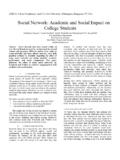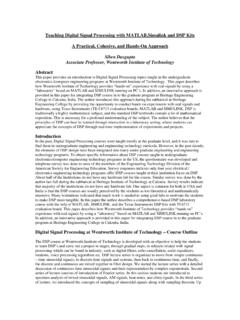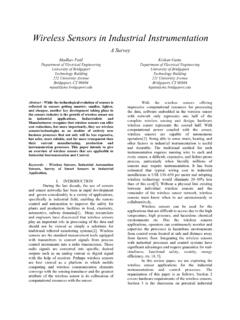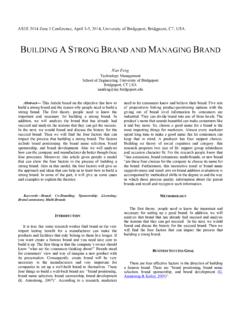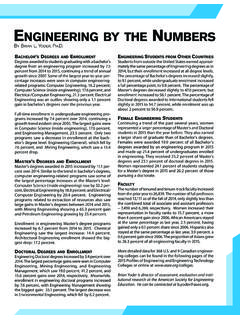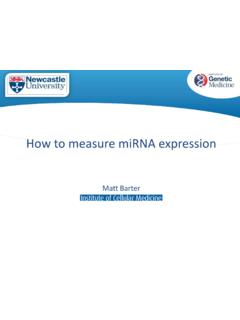Transcription of Maximizing Total RNA Yield from TRIzol® …
1 ASEE 2014 Zone I Conference, April 3-5, 2014, University of Bridgeport, Bridgpeort, CT, USA. Maximizing Total RNA Yield from trizol . Reagent Protocol: A Feasibility Study Nicholas J Macedo Tracie L Ferreira Department of Bioengineering Department of Bioengineering University of Massachusetts, Dartmouth University of Massachusetts, Dartmouth Dartmouth MA, United States Dartmouth MA, United States Email: Email: Keywords RNA; optimization; cDNA synthesis; zebrafish ABSTRACT. This work aimed to optimize RNA isolation from samples of limited size using trizol reagent. Investigated were the effects of certain variables, especially the amount of trizol reagent used in homogenization of samples and exposure to freezing conditions, on Total RNA isolation from vertebrate tissue. Initially, it was possible to optimize the amount of trizol used for the initial homogenization of amputated zebrafish caudal fin tissue. Samples were then prepared in three groups; RNA was isolated immediately following homogenization (0 hour) and after 1 hour and 24 hours of being snap- frozen in a -80 C freezer.
2 Lastly, since extraction of RNA in the aqueous phase involves elution with 24:1 chloroform/ isoamyl alcohol after the initial homogenization step of the protocol, also examined was how the volume of chloroform/ isoamyl alcohol impacted Yield . The experimental techniques were then applied to isolating RNA from regenerated zebrafish tissue 24 hours post- amputation of the caudal fin for a study investigating gene regulation in regenerated tissue. Functional studies included cDNA synthesis and sequential RT- PCR to evaluate quality mRNA extraction by employing these optimized methods. After additional validation, the techniques were then applied to extraction of Total RNA from a single zebrafish embryo at 4- cell, high, and 24 hpf stages of development. It was observed that this optimization process yields quality RNA (RIN ~ ), and there exists significance in the amount of reagents applied to a sample versus the amount of RNA obtained from the extractions.
3 INTRODUCTION available through commercial vendors that offer reliability in nucleic acid Yield . New England Biolabs In molecular biology, isolating quality RNA is a offers a magnetic isolation kit which exploits the critical first step in any analytical follow up poly(A) tail in mRNA and is most effective when processing technique such as Reverse Transcription used on cells and tissue [1] which improves greater PCR (RT- PCR) or Quantitative/ Real Time PCR amounts of primary transcripts in the starting sample. (qPCR) as well as Northern Blot analysis of Qiagen Technologies' RNeasy Mini Kit utilizes transcripts. Obtaining sufficient starting material for silica- membrane embedded spin columns for binding cDNA synthesis is heavily dependent on proper capacities up to 100 g of single strand material. precautions when handling RNA, but even more Each offers a unique mechanism for isolating quality important is ensuring that the chosen protocol RNA.
4 Optimizes Yield as well as quality. Often it is the less abundant RNA species that are sought after for The wholesome and accurate isolation of mRNA is analysis. There are multiple established products important in studying microRNA (miRNA) and their UB ASEE 2014 Zone 1 Conference - pg 1. regulatory functions in morphogenesis [2]. fluids, tissues, and cells, and has been used to extract Furthermore, careful screening of these small RNA RNA from plasma and the nucleic acid recovered fragments in small amounts of sample tissue could was then utilized in qPCR reactions [9]. Even from lead to breakthroughs in protocols for tissue cervical samples, isolated RNA for use in the analysis engineering as well as therapies for cancer of HPV oncogenes which are normally costly to malignancies [3]. Most functioning cancer pathways detect in vivo was then carried to the next step after have been proven to be regulated by relatively small purity analysis for cDNA synthesis [10].
5 One study traces of mRNA sequences [4- 7], it is therefore used trizol reagent as a co- extraction method for crucial to recover the majority of the RNA in such isolating RNA from formalin-fixed paraffin- samples for further processing. embedded specimens that had been stored for extended amounts of time, and showed significant The zebrafish is an effective animal model for quality starting material for PCR to further studying regenerative tissue processes through investigate the archived specimens in subsequent various molecular signaling events, and could studies [11]. potentially be of significant importance to biomedical engineers for studying stem cell involvement in such The goal of this work was to optimize RNA. occurrences. The zebrafish has the ability to regrow extraction from small portions of regenerated caudal caudal fin tissue while sustaining tissue regrowth for fins to improve analysis of cell signals during a defined timeline post- amputation, and slight regeneration.
6 RNA extraction from single cell alterations in cell signaling factors could potentially embryos was also optimized. offer explanations for the inability of these events to occur rapidly and freely in humans. Gene expression MATERIALS AND METHODS. from early embryonic stages throughout adult 1. Developing an Optimal Protocol for Extraction of RNA. development of the zebrafish must be studied in a from Zebrafish Caudal Fin Tissue. quantifiable manner should therapeutics be derived from this animal model for human oriented 1A. Optimizing Initial trizol Volume for a Defined applications. In one study, a process was developed Tissue Sample. for maximal RNA isolation from a single zebrafish A standard amount of zebrafish caudal fin was embryo at various stages of development whereas amputated and homogenized in varying amounts of most methods called for 10 embryos at the minimum trizol in order to isolate Total RNA. In the for sufficient RNA Yield [8].
7 Establishment of preliminary isolation experiments, areas of amputated inexpensive yet reliable isolation methods for fin tissue from zebrafish were measured using image maximal RNA Yield is significant, and adds to the J software (NIH Bethesda, Maryland) and then toolbox of the modern researcher. amputated accordingly. Volumes of trizol reagent trizol reagent from Invitrogen is an economical in sterile centrifuge tubes at 50, 100, 150, 200, 250. yet effective phenol based medium that is used by L volumes were chilled on ice prior to many investigators primarily involved in molecular homogenization of the tissue. Tissue was biology and the biotechnology disciplines. After homogenized using a mechanical pestle (Fisher homogenization of tissue or cells, chloroform is used Scientific, item#12-141-368), and extracted using to extract RNA from the homogenate in an aqueous manufacturer's recommended protocol. Concentration layer and all remaining protein complexes are and purity (A260/ 280 ratio) readings were read using collected in a lower phenol- red formed organic layer.
8 A NanoDrop Lite Spectrophotometer from Thermo The isolation process using this reagent can be Scientific. successfully completed in less than one hour, and 1B. Testing the effect of Freezing Samples prior to RNA. assuming sterile technique can be used to extract extraction on Yield . RNA in pure form (A260/280 wavelength ratio greater than or equal to ). This chemical reagent Fin tissue was amputated as stated above and two sets can be used to thoroughly isolate RNA from bodily (50, 100, 150, 200, 250 L) were frozen in a -80 C. UB ASEE 2014 Zone 1 Conference - pg 2. the 50 L volume of trizol reagent prepared 24 HR FROZEN. earlier. 1 HR FROZEN ! CAUTION: This should be performed on a sterile 0 HR FROZEN surface and with a sterile cutting utensil. 3| Using a mortar and pestle, completely homogenize the tissue ! TIMING 1- 2 min !CRITICAL STEP: Ensure tissue is submersed in the trizol reagent for complete disassociation.
9 ! PAUSE POINT: homogenate can be frozen for 24 hours at -80 C at this point if not able to continue. 4| Add 20 L of 24:1 chloroform/ isoamyl alcohol to the homogenate and vigorously shake for trizol Protocol 15 seconds. Figure 1. Flow Diagram of freezing experiments. 5| Centrifuge for 15 min at 12, 000 x g in 4 C. 6| Extract the aqueous layer that results after freezer for 1 and 24 hour periods. RNA was isolated centrifuging to a fresh centrifuge tube. using manufacturer's recommended protocol (FIG 1). !CRITICAL STEP: Be sure to extract the aqueous layer carefully; any lower organic phase 1C. Testing the Effect of Chloroform volume on Yield . contamination greatly decreases final product purity. Overall Yield requires efficient aqueous layer The original instructions found in the manufacturer's removal during this step. protocol calls for the addition of mL of 7| Add 25 L of isopropanol to the extracted chloroform to each sample for every mL of aqueous layer, and mix by inverting 2- 3 times.
10 trizol reagent used in homogenization. For 8| Centrifuge for 10 min at 12, 000 x g in 4 C. experimental tests, and 1 mL of 24:1 chloroform/ 9| Decant the supernatant. Given the Total isoamyl alcohol was used for every 1 mL of trizol volume, gentle tapping on a solid surface may be reagent in the phase extraction step (20 and 50 L needed to aspirate. respectively). 10| Add 50 L of 75 % cold ethanol (in DEPC. treated water) to the centrifuge tube, and mix by FINAL OPTIMAL PROCEDURE FOR RNA. ISOLATION FROM FIN TISSUE inverting 2- 3 times. 11| Centrifuge for 5 min at 7,500 x g in 4 C. Prepare a sterile mL centrifuge tube prior to 12| Decant the supernatant. Given the Total beginning the protocol with 50 L of trizol volume, gentle tapping on a solid surface may be reagent stored on ice. trizol reagent contains needed to aspirate. phenol (toxic and corrosive) and guanidine 13| Air dry the RNA ! TIMING 5- 10 min isothiocyanate (an irritant), and may be a health !
